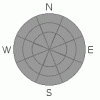|
Well, this is the end of the line for the 08-09 western Uinta forecast season. No I’m not going to Disneyland; I’m going on a Wasatch ski holiday instead. But in the absence of my avalanche advisory here are a few pointers to help you make your own snowpack and avalanche danger evaluations.
In general you can count on several types of avalanche conditions in the spring. Whenever we get a storm the avalanche danger will rise, as the new snow might not bond well to the existing hard, slick crust it falls on. As always, recent avalanche activity as well as cracking and collapsing of the snowpack are dead giveaways the snow is unstable. Even if these clues don’t present themselves, be sure to do some tests on smaller slopes that are similar in aspect, elevation and slope angle to what you want to ride on. Choose test slopes that have minimal consequences, especially after a significant snowfall. A well placed slope cut will give you a good feel for the stability of the slope. If there is much wind associated with the storm or if there is snow available for transport before it gets cooked into place, expect to find potentially unstable wind slabs on leeward slopes.
Also, when the sun first comes out and the snow goes through its initial rapid warm up, avalanches will be likely on steep slopes. You can expect the usual round of wet slides, but fortunately new snow instabilities tend to stabilize rather quickly in the spring due to the warm temperatures. When the snowpack goes several nights without a good solid refreeze, deep wet slab avalanches are possible, especially in steep, rocky terrain. Given this year’s unusual Thanksgiving rain crust, I’d expect to see large avalanches breaking to the ground. These will be tree snapping, bone shattering, sled crushing avalanches… you get the picture. During the heat of the day you’ll want to get off of and out from underneath steep slopes and avoid terrain traps such as gullies or steep road cuts where cement-like debris will pile up very deeply.
Talking with other folks around the range, we’re amazed at how big cornices have grown, especially during the April storm cycle. As a matter of fact, they’re epically huge and may break back much further than you’d think. I’d continue to give these unpredictable pieces of snow the respect they deserve and avoid messing around with them, especially when the strong springtime sun is beating down on them and they’re feeling like an ant under a magnifying glass.
The blockbuster spring produced larger- than- life coverage, so get out and get after it, but continue to be diligent with your safe riding techniques. When you’re in avalanche terrain have only one person on the slope at a time and always carry a beacon, shovel and probe. |

